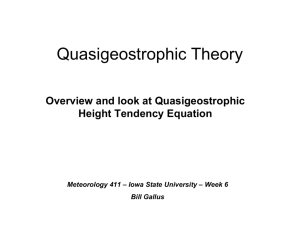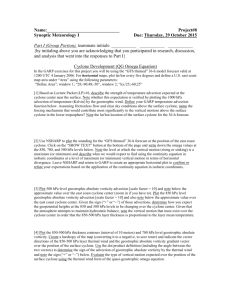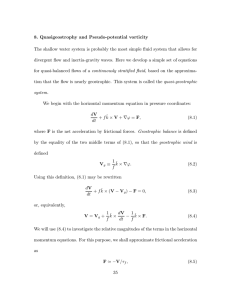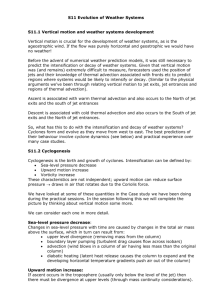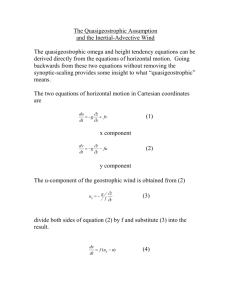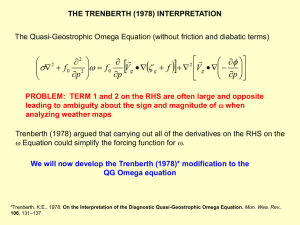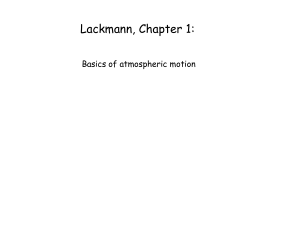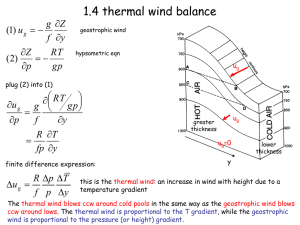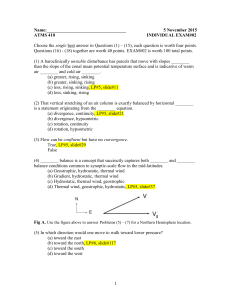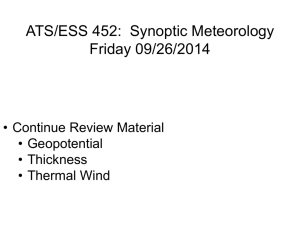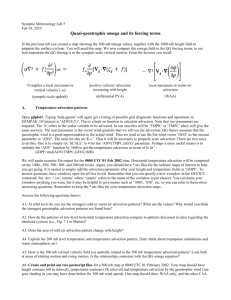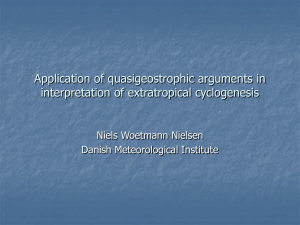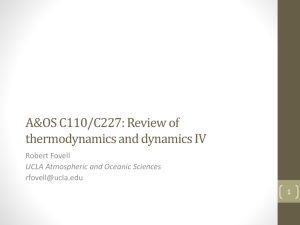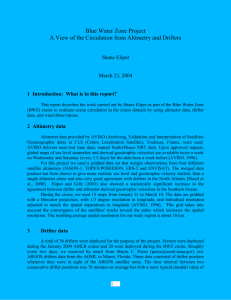Project#9
advertisement
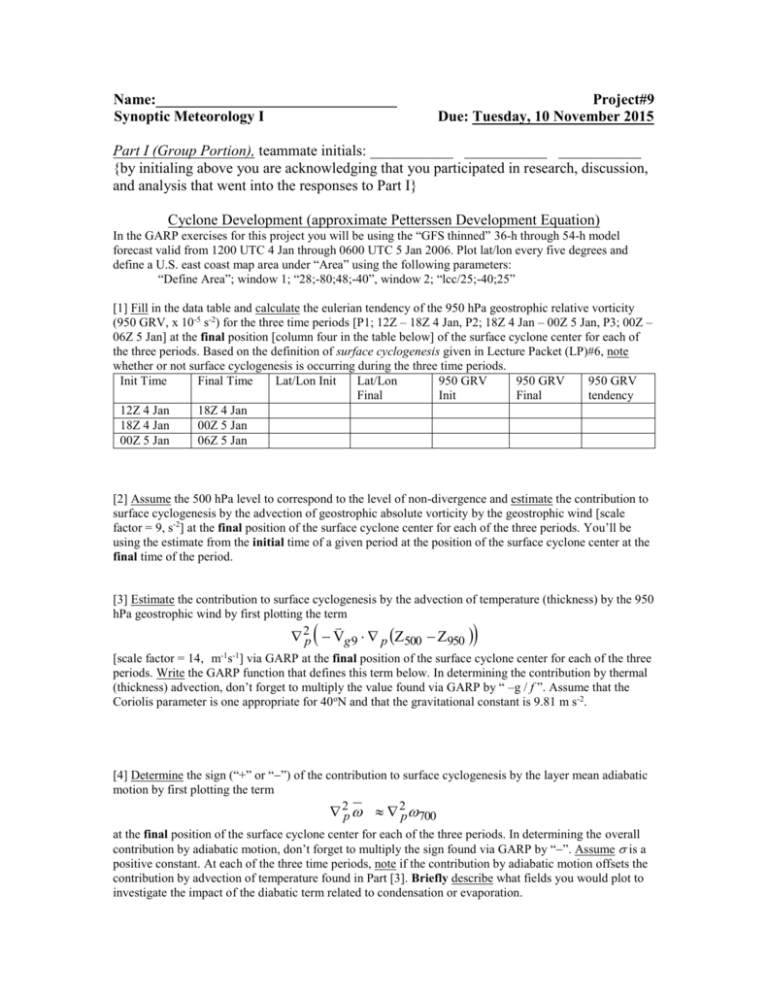
Name:________________________________
Synoptic Meteorology I
Project#9
Due: Tuesday, 10 November 2015
Part I (Group Portion), teammate initials: ___________ ___________ ___________
{by initialing above you are acknowledging that you participated in research, discussion,
and analysis that went into the responses to Part I}
Cyclone Development (approximate Petterssen Development Equation)
In the GARP exercises for this project you will be using the “GFS thinned” 36-h through 54-h model
forecast valid from 1200 UTC 4 Jan through 0600 UTC 5 Jan 2006. Plot lat/lon every five degrees and
define a U.S. east coast map area under “Area” using the following parameters:
“Define Area”; window 1; “28;-80;48;-40”, window 2; “lcc/25;-40;25”
[1] Fill in the data table and calculate the eulerian tendency of the 950 hPa geostrophic relative vorticity
(950 GRV, x 10-5 s-2) for the three time periods [P1; 12Z – 18Z 4 Jan, P2; 18Z 4 Jan – 00Z 5 Jan, P3; 00Z –
06Z 5 Jan] at the final position [column four in the table below] of the surface cyclone center for each of
the three periods. Based on the definition of surface cyclogenesis given in Lecture Packet (LP)#6, note
whether or not surface cyclogenesis is occurring during the three time periods.
Init Time
Final Time
Lat/Lon Init
Lat/Lon
950 GRV
950 GRV
950 GRV
Final
Init
Final
tendency
12Z 4 Jan
18Z 4 Jan
18Z 4 Jan
00Z 5 Jan
00Z 5 Jan
06Z 5 Jan
[2] Assume the 500 hPa level to correspond to the level of non-divergence and estimate the contribution to
surface cyclogenesis by the advection of geostrophic absolute vorticity by the geostrophic wind [scale
factor = 9, s-2] at the final position of the surface cyclone center for each of the three periods. You’ll be
using the estimate from the initial time of a given period at the position of the surface cyclone center at the
final time of the period.
[3] Estimate the contribution to surface cyclogenesis by the advection of temperature (thickness) by the 950
hPa geostrophic wind by first plotting the term
2p Vg 9 p Z500 Z950
[scale factor = 14, m-1s-1] via GARP at the final position of the surface cyclone center for each of the three
periods. Write the GARP function that defines this term below. In determining the contribution by thermal
(thickness) advection, don’t forget to multiply the value found via GARP by “ –g / f ”. Assume that the
Coriolis parameter is one appropriate for 40 oN and that the gravitational constant is 9.81 m s-2.
[4] Determine the sign (“+” or “”) of the contribution to surface cyclogenesis by the layer mean adiabatic
motion by first plotting the term
2p 2p700
at the final position of the surface cyclone center for each of the three periods. In determining the overall
contribution by adiabatic motion, don’t forget to multiply the sign found via GARP by “”. Assume is a
positive constant. At each of the three time periods, note if the contribution by adiabatic motion offsets the
contribution by advection of temperature found in Part [3]. Briefly describe what fields you would plot to
investigate the impact of the diabatic term related to condensation or evaporation.
Name:________________________________
Synoptic Meteorology I
Project#9
Due: Tuesday, 10 November 2015
Part II (Individual Portion):
The text version of the approximation to the Petterssen Development Equation is expressed as:
GRVT = GAVA + LTHAD + LAD + LDIA
where GRVT is the geostrophic relative vorticity tendency at 1000 mb, GAVA is the 500 mb geostrophic
absolute vorticity advection, LTHAD is the horizontal laplacian of the 1000-500mb mean thickness
advection by the1000 mb geostrophic flow, LAD is the horizontal laplacian of the 1000-500mb mean
adiabatic thermal term, and LDIA is the horizontal laplacian of the 1000-500mb mean diabatic thermal
term. Plotted above is the contribution to cyclogenesis (GRVT > 0) or cyclolysis (GRVT < 0) by LTHAD,
a linear function of distance in the east-west direction for a location in the Northern Hemisphere. Determine
the mathematical form of the 1000-500mb mean thickness advection by the 1000 mb geostrophic flow
(THAD) given the conditions; (1) LTHAD = -T at x = -L, (2) LTHAD = T at x = +L, (3) THAD = A at x
= +L, (4) THAD = 0 at x = 0, and (5) THAD is a function of the east-west direction only.

